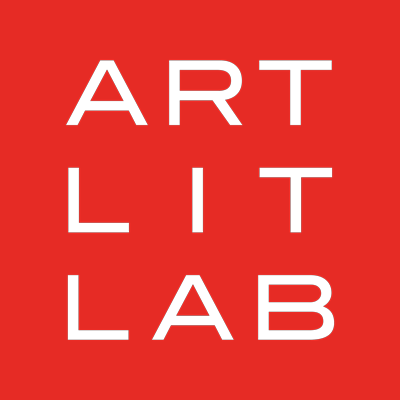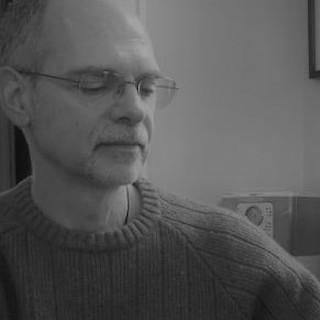(T)he intimate and discomforting process of trying to figure something out while doing it. I don't know if that's abstraction, but I know it's awkward. Finding a form is building these feelings (in this case, dissatisfaction, embarrassment, and doubt) into a substance.
—Amy Sillman, "Notes on Awkwardness"
As the writer, I'm not going to say, 'He's standing there awkwardly.' That's breaking the rule of writing-- show, don't tell. So I want to show how this for him, how in the awkwardness there is also a longing and a sadness and a confusion.
—Jacqueline Woodson, from a 2019 The Seattle Times interview
ALL Review: When contemplating awkward experiences, we may recall problematic attempts to communicate or actual physical sensations. In the installation, many pieces evoke intensity, and several are displayed at unusual levels. The intent seems to be both empathetic and immersive. Can you tell us more about what led you to this approach?
Liz and Kathleen: Yes, "problematic attempts to communicate" is an ideal phrase, and "awkwardness" might be an ideal single word for that. We wanted the work at various levels to both consciously challenge conventions of "eye level" display and to bring a physical awareness of active viewing and movement in experiencing the work: we amplify the installation as a whole piece itself; the space itself functions as an important collaborator.
AR: Liz, in“Green Tone," we may observe the interaction between two figures, one upright, the other lying face down. All components in the work painting are in shades of green. Can you comment about the use of this color? Is it reflective of the interaction between the two figures?
Liz: Early on Kathleen and I talked about using a limited color palette (pink, violet, gray, and olive green) for the drawings included in Awkward. I was curious about making a work that is primarily green while mixing in pink, violet, and gray to create a range of tones. I’ve been thinking about green more and more as our landscapes (tragically) change in hue. The figures were painted loosely in reference to a photograph from a previous era.
AR: Kathleen, the painting “Perimeter” seems stark, emotional, and immediate. The images of horizontal lines and harsh x’s feel crowded. There are similar motifs in your earlier work, but there also seems to be more open space. Is “Perimeter” a transitional piece or is it examining space constrained by boundaries?
Kathleen: It’s very interesting that you describe Perimeter (together with Perameter) as possibly transitional. Yes, it did come from an experience of a very different kind of space. All of my abstracted and implied landscapes/places come from an experience of physical, cultural, and landscape space. Texas' expansive, exquisitely beautiful desert space is my ideal, opening out seemingly infinitely. But this drawing came from time spent at a wonderful residency in a valley surrounded by large mountains in Montana. I'll admit I felt hemmed in by that kind of landscape and also by the cultural conservatism. In Geography and Plays, a compilation of essays and other work, Gertrude Stein often returns to the theme of one's relationship to space or the placement of oneself in space.
AR: Liz, the video “Untitled (birds)” includes footage of a bird trapped in a crowded airplane cabin, a large plastic swan figure being inflated in a room that’s likely too small to contain it, and a live swan either biting or feeding from the free hand of the person recording the interaction. The tension and humor in these scenes is paired with “Purple Stage," in which we see a spotlight on a closed stage curtain and hear riffing on a cymbal. The spotlight wobbles, as if the lighting technician is wondering what the audience may be wondering — is something going to happen? Are these videos exploring awkwardness in the form of thwarted expectations?
Liz: Absolutely, yes. I was playing with notions of anticipation and the bodily experience of feeling out of place. I turned to animals to consider how bodies inhabit the contemporary world. The clips (some found, some recorded) exhibit absurdity and precarity. I was also thinking about our often self-destructive relationship with nature and the awkward situations that result from our desire to conquer the natural world — i.e., a bird flying on a plane.
AR: Kathleen, the pedestal wall sculptures seem to present abstract ideas (dangling in each mobile), rising up to assembled thoughts (books), and crowned by loose boundaries (the ceramic gridforms). Are these pieces tracing the journey of the content in each book from abstractions to interpretation? Is this getting at the awkwardness that can arise through communication? Can you tell us about the use of reggae colors (red, yellow, green, and black) in the ceramic pieces?
Kathleen: You as a writer bring a beautiful analysis I couldn't give words to, illuminating a level of meaning I might only sense, and in an awkward effort, give form to. Yes, the books are chosen for their titles and content — approaches to experience, frameworks to perceive through. The awkward/abject ceramic gridform is a quickly coiled and pinched gridform that doesn't offer the same fixed ways to locate within x/y coordinates, but it makes an effort, atop other ways to locate/understand the world (books, knowledge).
I consider reggae colors very beautiful in their color interaction (complementary and high contrast), but most of all as associative colors from a protest music that changed my worldview at a young age. Discovering reggae as message (not dance reggae, but protest reggae) and also as a new, rhythmic beat that deeply vibrated one’s bones, one's interior, was amazing to me, and still moves me. The mobiles were adapted, as I was advised that things could not hang in the room, but it worked out well more sculpturally integrated.
AR: Liz, the two untitled paintings (acrylic brown and purple; gouache blue triangles) seem bold and intense when compared to your other works on paper, which seem lighter in mood. Do you sense a transition in your painting? Kathleen’s paintings use geometric forms. Both untitled works include triangular imagery. Can you comment on the importance of this motif?
Liz: It’s interesting that you find the figures to be lighter in mood. Strangely enough, the untitled paintings were made just after a surgery in December 2022 — I was limited to drawing/painting only while seated and under the influence of pain meds. The more figurative works were made prior to this while standing up and with the ability to move more freely. Now I’m thinking about Kathleen’s comment about Gertrude Steins's Geographies essays. Maybe it was my bodily space that affected my thinking space. As far as your question about triangular imagery — I don’t remember this coming up in our conversations. We did talk about diagrams and diagrammatic thinking. That lends itself to geometric forms and triangular imagery.
AR: You both contributed to the photo-posters which show your paintings displayed with pieces of plywood. How did these collaborative pieces come about?
Liz and Kathleen: Plywood is wonderfully ordinary, and leaning it against a wall, it looks awkward and temporary. But it is a great support material, and being found pieces, they offered sculptural adaptations to what we had to work with on the spot. We originally planned to install work in the gallery space this way, but the collaborative experimenting with photographic set-ups of work resulted in an exciting and seamless form — a physical bringing together of our work into a single finished work. We chose our work together, and Liz is a really great photographer. So after an initial playing around with choices, she set up the work and photographed it and then we printed them digitally together. We found an exciting freedom and trust in process which resulted in something really new and satisfying.
AR: Kathleen, when compared to your previous work, the use of words in your drawings and paintings seems to be a recent development. Can you tell us about your use of words? In contrast to the other pieces in the installation, the mood of “HowWho” seems lighter. Did you want to convey a gentler tone with this piece?
Kathleen: I use words in an ancillary daily drawing practice I have, called daily news anxiety drawing (they have slowed now that we have a new administration). I love words and sometimes find myself compartmentalizing a complex preoccupation in that satisfaction/distillation of a single word — and sometimes rest on a word to draw just for a word’s nuances and sounds…. “How Who” happened as an exploration of kerning/spacing letters; I found that linking letters loosely could make two words that could set a tone in an odd ground/setting space—opening out meaning and sounds.
AR: There seemed to be linkages between some pieces. The content in “Untitled (birds)" could be tied to the physical awkwardness evoked in the painting "Perimeter." The posters, while documenting the collaboration, could also be seen as a realized "expectation" of a collaboration. This seemed linked to the video “Zoom Test (Mustang)," where we see a Rent-a-Center truck covered with expectancy-phrases: ”We make it easy to make it your own" and "Instant Home Improvement.” Were these links planned?
Liz and Kathleen: This question magnifies what makes collaboration so dynamic — the unexpected juxtapositions, the combinations and influence that can only happen through a "surrender" to things that will happen when working together with another artist (often more freely, in a spirit of “play" — intuitively). We admire each other's work, our individual ways of thinking and making. Our choices for work in the show — the choices made for the photographs — were mostly intuitive, but then discussed. And you, as a writer really spending time with our work, bring an unusually deep read of signifiers that adds another really exciting level of collaboration.



